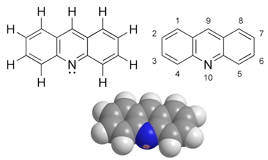Acridine
A heterocyclic organic compound and its derivatives
| Chemical compounds | ||||||||
|---|---|---|---|---|---|---|---|---|
This chemical compound related article is a stub.
|
Acridine is an organic compound and a heterocyclic compound that is structurally related to anthracene. It is a planar molecule and is known for its role in the synthesis of dyes and drugs. Acridine and its derivatives are important in the field of chemistry and biochemistry due to their wide range of applications.
Structure and Properties[edit | edit source]
Acridine is a tricyclic aromatic compound with the chemical formula C13H9N. It consists of three fused rings, two of which are benzene rings, and the third is a pyridine ring. The nitrogen atom in the pyridine ring is responsible for the basicity of acridine.
Acridine is a colorless solid that is soluble in organic solvents. It exhibits fluorescence, which makes it useful in various analytical applications. The compound is also known for its ability to intercalate into DNA, which is a property exploited in certain types of biological research and pharmacology.
Synthesis[edit | edit source]
Acridine can be synthesized through several methods, one of the most notable being the Bernthsen acridine synthesis. This method involves the condensation of a diarylamine with a carboxylic acid in the presence of zinc chloride.
Another method of synthesis involves the cyclization of N-phenylanthranilic acid. These synthetic routes are important for producing acridine derivatives used in various applications.
Applications[edit | edit source]
Acridine and its derivatives are used in the production of dyes, such as Basic Yellow 9, which is used in textile and paper industries.
In addition to dyes, acridine compounds are used in the development of pharmaceuticals and antiseptics. Their ability to bind to DNA makes them useful in biological staining and as fluorescent probes.
Biological Activity[edit | edit source]
Acridine derivatives have been studied for their antimicrobial and antitumor properties. The intercalation of acridine into DNA can disrupt cellular processes, which is a mechanism explored in the development of certain chemotherapeutic agents.
Safety and Handling[edit | edit source]
Acridine is a hazardous compound and should be handled with care. It can cause skin irritation and is harmful if ingested or inhaled. Proper safety measures, including the use of personal protective equipment, should be followed when working with acridine.
Related pages[edit | edit source]
Gallery[edit | edit source]
Search WikiMD
Ad.Tired of being Overweight? Try W8MD's physician weight loss program.
Semaglutide (Ozempic / Wegovy and Tirzepatide (Mounjaro / Zepbound) available.
Advertise on WikiMD
|
WikiMD's Wellness Encyclopedia |
| Let Food Be Thy Medicine Medicine Thy Food - Hippocrates |
Translate this page: - East Asian
中文,
日本,
한국어,
South Asian
हिन्दी,
தமிழ்,
తెలుగు,
Urdu,
ಕನ್ನಡ,
Southeast Asian
Indonesian,
Vietnamese,
Thai,
မြန်မာဘာသာ,
বাংলা
European
español,
Deutsch,
français,
Greek,
português do Brasil,
polski,
română,
русский,
Nederlands,
norsk,
svenska,
suomi,
Italian
Middle Eastern & African
عربى,
Turkish,
Persian,
Hebrew,
Afrikaans,
isiZulu,
Kiswahili,
Other
Bulgarian,
Hungarian,
Czech,
Swedish,
മലയാളം,
मराठी,
ਪੰਜਾਬੀ,
ગુજરાતી,
Portuguese,
Ukrainian
Medical Disclaimer: WikiMD is not a substitute for professional medical advice. The information on WikiMD is provided as an information resource only, may be incorrect, outdated or misleading, and is not to be used or relied on for any diagnostic or treatment purposes. Please consult your health care provider before making any healthcare decisions or for guidance about a specific medical condition. WikiMD expressly disclaims responsibility, and shall have no liability, for any damages, loss, injury, or liability whatsoever suffered as a result of your reliance on the information contained in this site. By visiting this site you agree to the foregoing terms and conditions, which may from time to time be changed or supplemented by WikiMD. If you do not agree to the foregoing terms and conditions, you should not enter or use this site. See full disclaimer.
Credits:Most images are courtesy of Wikimedia commons, and templates, categories Wikipedia, licensed under CC BY SA or similar.
Contributors: Prab R. Tumpati, MD




